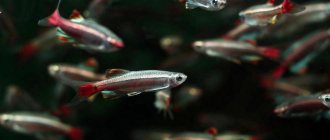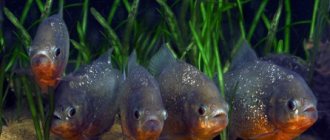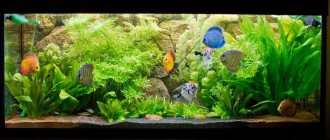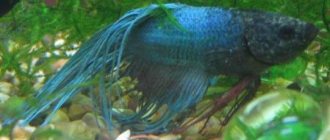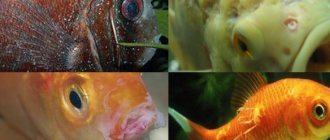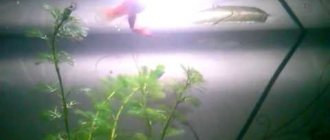We offer readers of our resource a visual and colorful list of aquarium fish with descriptions and photos of fish of each individual species. Our section for beginners contains the most popular fish that are especially popular among aquarists.
On the left you can see a photo of each individual fish, which includes a small description located to the right of the picture. All fish are divided into subsections to make it easier for you to navigate and identify this or that species or family.
Photos of Catfish and Loaches
There are probably catfish in every aquarium, regardless of the overall species composition. Look below at the aquarium fish - photos with the names of catfish will help you decide on your future deep-seated inhabitant of the aquarium.
All catfish are different sizes, so it is very important to study their possible adult size before choosing.
Ancistrus
A rather small fish that can live in aquariums from 30 liters. The classic color is brown. Often these small catfish are confused with their larger counterparts - pterygoplichts. In general, it is a very hard-working fish and is good at cleaning build-up.
Ancistrus yellow
This ancistrus is also called golden. By the way, this is a very good color for maintaining an aquarium according to Feng Shui, since the aquarium simply must have a gold-colored fish according to this ideology. Can grow to the same size as brown anciks.
Pterygoplichthus
It is also called the chain-mail catfish. Pterygoplichthys can grow up to 50 centimeters in home aquariums, making them one of the most spectacular fish. They lead a bottom-dwelling lifestyle; if they do not have enough space, they begin to actively chase other inhabitants.
Tatsia
The most popular is the stellar one. It grows to a small size - 10-12 centimeters, is mainly nocturnal, and sleeps during the day. A very interesting and beautiful catfish, but the fact that it is active only at night does not allow them to be admired to the fullest.
Crossocheilus
There are different types of Crossocheilus, but in general they are all very similar. These fish have a suction cup, which can clean not only growths on glass, but also flip flops on leaves. Hardworking fish, they can grow up to 15 centimeters.
Redtail catfish
One of the largest aquarium fish, they grow without stopping and eat everything that fits into their mouth. These catfish are very beautiful, but due to their appetite and predatory tendencies they do not get along well with smaller fish. A striking feature can be seen in the photo - a red caudal fin.
Corridoras
Very cute and nimble catfish Corydoras. We would compare them to the Pomeranian of the dog world. A small bottom-dwelling fish that does not require special conditions feeds on what it can find at the bottom. As a rule, they are 2-10 centimeters long. If you don’t know who to put in the aquarium, buy Corydoras.
Botia clown
This type of bot is the most popular among aquarists. Most likely due to the fact that clowns look very impressive, as can be seen in the photo. The peculiarity of the fish is the spikes that are located under the eyes. These spines can extend when the fish is in danger. They can live up to 20 years.
Botia modesta
Another fish from the loach family. The peculiarity of the color of such bots is blue or light blue and bright fins. The color of the fish can change depending on its mood. In an aquarium, such fish can grow up to 15 centimeters in size.
Botia marble
It is in this marbled coloring that the fish most closely resembles the Corydoras catfish. Like other bots, marbled ones are active exclusively at night, when they go out in search of food, and during the day they most likely will not be very visible to their owners.
Synodontis eupterus
In general, these catfish are completely peaceful inhabitants of the aquarium. These fish are schooling, and this should be kept in mind. The peculiarity of this species is its dark color and large dorsal fin. Such a fish will most likely grow up to 12-13 centimeters in an aquarium.
Synodontis petricola
Unlike eupterus, it has a light color with dark spots, due to which it can look even more impressive. The fish has a clear tendency to be nocturnal, so it may not appear very often during the day. The optimal volume for it will be from 60 liters.
Synodontis changeling
There are some species of synodontis that are called shifters because of their characteristic feature of swimming belly up. These catfish also require an aquarium of medium volume or more - from 60 liters. In all behavioral characteristics, the catfish changeling is similar to its fellow synodontis.
Pangasius (shark catfish)
This catfish is also called shark because of its characteristic appearance - this is clearly visible in the catfish photo (dorsal fin, body shape, etc.). Catfish can grow to gigantic sizes, so even a 200-liter aquarium will be small for it. The optimal volume is from 500 liters.
Plants for the aquarium
Any greenery is extremely important for the aquarium, and especially for its inhabitants. Greens, contrary to all opinions, have many useful functions. For example, it provides the fish with shelter, creates the necessary shade, and also improves the appearance of the aquarium. They also increase the amount of oxygen in the water, neutralizing ammonia that is harmful to the animal world.
The plants are very easy to care for; sometimes it is even difficult to evict them from the aquarium if they have grown beyond their size. Main types of plants:
- floating. Those that are on the surface of the water. This includes duckweed, frogweed;
- unrooted plants are those that cannot be planted in the ground. They live on various snags or decorations. These include Java moss, hornwort, anubias;
- rooted plants are those that are planted directly into the ground. These include cryptocoryne, arrowhead, and vallisneria.
It's much easier with plants than with fish. It is very, very simple to identify a plant that is not suitable for beginner aquarists - it has a color close to bright red.
Carp
Cyprinids in the aquarium are the most popular, primarily because of their unpretentiousness. We invite you to familiarize yourself with photos and descriptions of fish from this family.
Cherry barb
Cherry barbs have a color characteristic of their name - the body is light cherry color, with a horizontal black stripe characteristic of barbs. This fish is small (up to 2-3 cm), and can live quietly in aquariums of 15-20 liters. Males are brighter and redder than females.
Sumatran barb
Perhaps one of the most spectacular types of barbs - for this reason it is considered one of the most popular of its kind. They must be kept in a school, which makes the fish even more spectacular. The size in an aquarium is up to 4-5 centimeters.
Torpedo Barb
One of the largest barbs is the torpedo-shaped barb. They can grow up to 50-60 centimeters depending on the volume, and they need it from 200 liters. The fish are beautiful, but, like many cyprinids, they love to eat plants. It is better to keep them in a small flock of 3-5 individuals.
Scarlet Barb
The scarlet barb is shaped like a Sumatran barb. The fish has silvery scales, and a bright red stripe runs along its entire length in the middle of the body. This fish is unpretentious, like all barbs, and will live peacefully together with guppies, neons and other small barbs.
Fire barbs
The peculiarity of fire barbs is their bright golden body color and black back. These fish can be called gold, which again is not bad according to Feng Shui :). This fish is active and will constantly move, as a result of which it will become a decoration for any small aquarium.
Shark barb (bala)
Shark bala or barb is a fish that was so named as a result of its resemblance to sharks (this can be seen from the photo of the aquarium fish next to the description). These fish are large, they can grow up to 30-40 centimeters, so it is better to keep them together with other large barbs in a volume of 150 liters or more.
Mossy barb
It is also called the green barb due to the characteristic color of its scales. The fish is small, but at the same time spectacular and unusual. Also, it is rarely found in aquarium stores.
Microassortment galaxy
A very bright, and therefore very popular fish among aquarists. This fish is a schooling fish, and due to its bright rainbow coloring, a school can be very impressive. It grows to only a few centimeters and gets along well with neons, guppies, etc.
Leopard zebrafish
In our opinion, the fish is very similar to a miniature rainbow trout - it is because of the coloring that the zebrafish got its name. The fish are not large, up to 3-4 centimeters, very nimble, constantly on the move.
Danio pink
The pink color suits these fish very well, and they look very impressive, especially if they live in a school of more than 10 individuals. The fish is oblong in shape.
Danio rerio
A small fish up to 5 centimeters long. It is not difficult to recognize due to its coloring - a black body with longitudinal white stripes. Like all zebrafish, it is a nimble fish that never sits still.
Aquarium pets are not for beginners
Very often, people, carried away by the appearance of a particular fish, immediately drag it into their aquarium, and then are also indignant that it has not taken root. This is fundamentally wrong.
Names of the most unsuccessful fish species for the first experiment:
- roosters. They can be found in any market, they are very colorful and very beautiful, they can have an iridescent red or blue tail. In addition, they eat almost anything they can get their hands on, but it’s not for nothing that this fish was named that way. Roosters are very conflicting fish, one of the most conflicting fish that exist. By the way, they are so conflict-prone that it is better to keep them completely alone. And even then, there is a risk that the rooster will jump out of the aquarium (if there is no lid on it). If you put a betta with other fish, they risk being left without fins and getting seriously injured. The colors, however, are pleasing: blue, red, orange;
- African cichlids fully correspond to the previous characteristics ; you need to be just as careful with them;
- glass catfish A fish that will definitely surprise absolutely everyone with its appearance. It is almost completely transparent. However, it is very sensitive to any changes in the aquarium. Aquariums are a delicate science, and the experience of keeping such fastidious fish comes with time, and these are definitely not the best animals for the first attempt.
Goldfish and others
Golden
Classic goldfish belong to the genus crucian carp. They can come in a variety of colors and grow to different sizes depending on the size of the aquarium. The classic color is red and gold. A very ancient breed of fish, for which it requires exceptional respect.
Golden Veiltail
Veiltails are a separate species of goldfish. The photo shows how the veil-shaped caudal fin develops. When choosing such fish to keep, be sure to choose the right neighbors, as other fish may bite the tail of the golden one.
Koi carp
A fairly large breed of fish, which is why they like to be kept in ponds. In the photo you see their characteristic color – white with bright spots of different colors. The fish are not whimsical, but the volume of the aquarium is the only and important parameter for them.
Telescope
Telescopes come in gold and black. As a rule, they are not very large in size, up to 10-12 cm, so they can live in aquariums from 60 liters. The fish is spectacular and unusual, suitable for those who love everything original.
Oranda fish - red cap
Some people find this fish extremely charming, while others may, on the contrary, consider it defective. And all because of the specific cap on top of the head - it’s a small growth, and not necessarily red. One thing is for sure, that the fish is unusual, but you yourself know the taste and color.
How to understand the variety of fish species
Fish, like other animals, are divided into families. Each species belonging to the same family has common features. Focusing only on them, you can predict whether the fish will get along with each other or break off their tails.
Viviparous carnivores
Swordtails
These are small fish that got their name because of their specific tail. There are black, orange, and combined colors. Swordtails are viviparous, so you can achieve offspring at home.
Guppy
Probably everyone has heard about such fish as guppies. They are small (up to 3 cm), easy to keep and not whimsical - that’s why they are loved. At the same time, they can be very spectacular; males have veil-shaped multi-colored tails. They are even more likely to produce offspring than mecheks.
Black mollies
There are black, orange, yellow, and also mixed breeds. In shape they are a cross between guppies and swordtails. The fish is larger than its relatives described above, so it requires aquariums of 40 liters or more.
Molliesia velifera
A fairly large subspecies of mollies - it can grow up to 15-16 centimeters. Based on this, choose the right size of your aquarium, as it must be at least 50 liters.
Pecilia
Pecilia are the personification of a whole genus - the Poeciliidae. They can come in a variety of colors, from bright orange to variegated with black splashes. Fish can grow up to 5-6 centimeters.
Petsiliev family
Most of these fish are suitable for breeding by beginning hobbyists. They are viviparous, which eliminates the need to create conditions for spawning. They are very prolific, peaceful and unpretentious, although there are exceptions.
Guppy
One of the most unpretentious aquarium fish. They tolerate slightly alkaline water with a pH of up to 8.5, but prefer neutral water with a pH of 7. These fish provide endless space to the breeder’s imagination. There are 13 tail shapes alone, 8 color types for females, and even more for males.
They get along with members of their family, although swordtails can pluck the bushy tails of guppies. But not only swordtails do this, but also cockerels, macropods and even peace-loving barbs. Ideal neighbors: Denmark, gouramis, catfish, cardinals, neons.
Very prolific, for every male there should be 2-4 females, these small fish are very temperamental.
Guppies are not one species, but several similar ones that interbreed, so the purity of the breed can only be maintained by keeping different species in different aquariums.
In aquariums you can find 7 species, the most popular are Common Guppies and Endler's Guppies, and the rest are difficult to find in stores. All of them belong to the genus Paecillium.
Pecilia
Plaecilias is the name of a genus that includes 33 species, including guppies and mollies. Actually, platies are as unpretentious as guppies. Peaceful.
Many of them prefer water of medium hardness, slightly salty with pH = 6.8-8.6. They reproduce easily. They can produce offspring with swordtails.
Swordtails
Swordtails are one of the most common aquarium fish. They each have a long sword on their tail. At the same time, they are peaceful, but two males in one aquarium will not do without fights.
The swordtail needs a small harem of 3-4 females, he drives one. However, this also applies to other platies, except that mollies are a little less temperamental.
Mollies
Another one of the first most common aquarium fish. Like everything else in its family, it is distinguished by a variety of color forms. There is no clear boundary between mollies and platies. Some species are classified either as one or the other. And different species produce viable offspring.
Labyrinthine
Gourami grumbling
This is one of the most common types of gourami. A very beautiful fish that has a bright pearl or green-bluish color. In aquariums they grow up to 5 centimeters.
Marbled gourami
The name gourami speaks for itself - the color of the fish is marbled, white and blue. Fish can readily breed in an aquarium, and the male will build a nest of foam, where the offspring will be raised.
Pearl gourami
A very popular fish among aquarists. As you can see in the photo, gourami are characterized by two long whiskers on the stomach, as well as a black stripe along the body. It is a classic representative of labyrinth fish.
Lyalius
Looking at the photo, I just want to call her a fat gourami :). In fact, the fish is very cute and beautiful. The color can be either silver-blue or red-raspberry. Lalius are shy, so we do not recommend disturbing them again.
Macropod
A good fish that does not like encroachment on its territory. Although she is beautiful, she requires proper treatment. It is better not to plant them with their own kind; there are enough females and males of this species in the aquarium; they can get along with neons, guppies and other small species.
Cockerels
The so-called fighting fish. Males can be extremely aggressive towards other males, and sometimes towards females, if they lack space. Bettas can be kept even in the smallest aquariums, as they are not sensitive to volume.
Characinaceae
Blue neon
A classic representative of neon. It has a red-blue color. These are one of the most spectacular fish, as they shimmer in the light, which is how they got their name. They can be kept in small aquariums of 10 liters or more. The fish is schooling, so it is better to have at least 4-5 individuals.
Red neon
The fish is very similar to neon blue, but in this case red is the predominant color. Fish must be kept in schools, so they are more comfortable, and you will have a more colorful presentation.
Black neon
Although the fish is less popular than its fellows, this does not make it look any less impressive. A school of such tiny fish can decorate any aquarium. We recommend keeping them in large herbal aquariums.
Tetra
Tetra fish love when there are a lot of living plants in the aquarium, and therefore oxygen. The body of the fish is slightly flattened, the predominant colors are red, black and silver.
Ternetia
Ternetia is also called the black tetra. The classic color is black and silver, with black vertical stripes. The fish is quite popular, so finding it in your city will not be difficult.
Black pacu
This fish stands out from other characins due to its size - in an aquarium it grows up to 40-50 centimeters. The pacu belongs to the piranha family, so it needs to select its neighbors very carefully.
Photo and description of Discus
We offer you photos and descriptions of aquarium discus fish for your reference. Fishes are very loved by many aquarists, and many do not recognize anyone else at all. Yes, the fish are very impressive, which is noticeable from the photo, but keeping them requires appropriate knowledge and even some skills.
Green discus
Green discus has a characteristic color - green-turquoise shades with black splashes. These fish grow up to a diameter of 15 centimeters in an aquarium. They are very sensitive to water and its parameters, so keeping these fish must be taken very seriously.
Red discus
The classic color for discus fish is red. Such fish require an aquarium volume of at least 100 liters. In general, as you already understand, this fish is not for beginners.
Heckel's discus
These fish are distinguished by their turquoise color with black vertical stripes. If you keep a flock of such fish in a 400-500 liter aquarium, then you will captivate any of your guests with the beauty of the aquarium.
Cichlids
Below are collected cichlid aquarium fish with photos and descriptions. Cichlids belong to the order Perciformes and mainly live in South America. These fish can be of various sizes, ranging from 2 centimeters to several tens of centimeters.
Yellow cichlid (hummingbird)
One of the most popular cichlid species. It has a lemon coloration with black edging on the fins. The fish get along well with their own kind, but if there are several males, tough battles can occur. They grow up to 6-7 centimeters in aquariums.
Dolphin cichlid
The color of this cichlid is blue. At the top of the head there is a protruding bump, as in the photo. Grows in an aquarium up to 8-10 centimeters. The fish is peaceful, so it is often recommended for keeping.
Red parrot cichlid
The name speaks for itself - the fish is bright red, even orange, sometimes yellow. The fish can be large and grow up to 20 centimeters or more, so take care of the volume of your aquarium.
Black-striped cichlid
Not the largest of the cichlids, it grows up to 10 centimeters. The fish, unlike its counterparts, does not have a bright color - its classic color is dark with vertical black stripes.
Astronotus
One of the largest cichlid fish, they can grow up to 30 centimeters. It is black in color with bright orange spots. With proper maintenance they can live more than 10 years.
Angelfish
Angelfish come in different colors and shapes, but they are all united by a body shape - like a triangle. An aquarium is recommended with a volume of 60 liters or more, for large individuals - from 100. It is better to keep a small group of angelfish of a similar size in the aquarium.
Akara
A popular species is Acara turquoise. A turquoise-colored fish with a bright edging. It grows in captivity up to 25 centimeters, so it is better to keep it with fish of the same size. We recommend an aquarium volume of 100 liters or more.
Apistogramma Cockatoo
From the photo you understand why the fish is called that - it seems to be shrouded in protruding feathers from above and below. It grows up to 8 centimeters and needs a medium-sized aquarium of 50 liters or more.
Family Catfish
Dozens of species of catfish are kept in aquariums. They are peaceful, crawl along the bottom in search of food. Clean the aquarium from food debris.
Of course, not all families of freshwater aquarium inhabitants are listed here. There are also loaches, characins, and then the exotic begins, where prices can reach tens of thousands of rubles per fish.
Rest
Arowana
It’s worth saying right away that the fish is one of the most expensive, which is why it is considered rare. It can grow up to 50 centimeters or more in an aquarium with a volume of 400-500 liters. This is an oblong silvery fish that stays mainly at the surface of the water.
Macrognathus
The snake-like fish, which constantly stays at the bottom, hides in snags and plants. As a rule, it grows to 10-15 centimeters. If there are small fish in the aquarium, he can eat them all when he goes out hunting at night.
Rainbows
The size of the fish varies, but in general they do not grow more than 8-10 centimeters. There are also smaller species. All fish are beautiful, silver in color, with different shades. The fish are schooling and live calmer in a group.
Tetradon dwarf
A miniature version of its larger sea counterparts. It grows no more than 2 centimeters long. Unfortunately, the fish does not live very well, if something does not suit it, it is very whimsical to the conditions. If there are small snails in the aquarium, he will definitely eat them all.
Name the big fish
The teacher explains that an object that seems huge is named using the appropriate suffix. Next he shows the pupils pictures. Children try to transform the names of the fish on display. For example:
- pike - pike;
- burbot - burbot;
- pike perch - judge;
- sturgeon - sturgeon;
- shark - shark;
- slope - slope.
